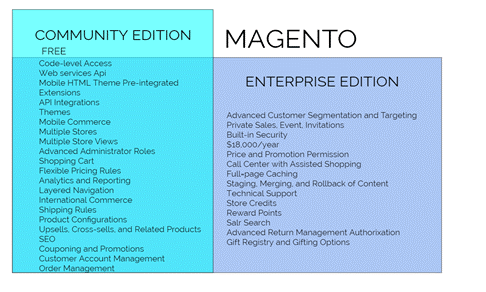Let's Talk !

Adobe Commerce vs. Shopify vs. Prestashop
Ecommerce Development ServicesTo create an e-commerce website you must first have a marketable product or service and decide how much you're willing to invest. Do the competitive market analysis and secure a domain.
If selling a product, calculate the appropriate shipping costs and whether or not free shipping fits into your budget. Brainstorm your branding strategy and choose an e-commerce platform that best fits your business type.
Finally, sign up and build your website by choosing a theme, adding content, images, sales deals, a contact page and more. Depending on the e-commerce platform you choose, you may need to enlist the help of a development partner, equipped with the platform-specific skills required for implementation. Lastly, install a SSL certificate to keep your customers information safe from hackers.
Main Points
Roughly 20% of all retail purchases will occur online in 2024. According to Forbes, this will likely increase to about 23% by 2027. And aside from online retail, e-commerce, in a broader sense, is expected to grow by nearly 9% this year.
Big data has altered the way retailers operate, as IoT and fully-integrated e-commerce platforms give way to new challenges. Customers expect their products at lower rates and higher quality, expediting checkout to deliver, engaging in highly relevant brand interactions.
To nurture an integrated retail structure, businesses are even changing their supply management strategies revolutionizing how customers receive their products/services and keeping all involved, from retailer to distributor.
Whether you are looking to revamp your current internet marketplace, in search of B2B e-commerce opportunities, or operating out of the trunk of your car, Adobe Commerce, PrestaShop, and Shopify are here to help.
Although no e-commerce platform is single-faceted and they all leverage an extensive user toolbox, it's important to understand which environments their tools thrive in and which environments they may fail, so that the new direction you take is the right one.
According to a white paper published in 2021 by IDC, a total average of 3.75 million transactions occur annually on Adobe Commerce platforms. About 1.6 million customers purchased products/services from businesses that used Adobe Commerce.
Before Adobe Commerce became a powerhouse commerce platform, there was another mega, B2B platform known as Magento. Launched in March 2008, Magento had a feature-rich, open-source e-commerce solution that offered merchants the flexibility of having total control over planning content for their online store. Magento took pride in its flexibility and capacity to stay ahead of the game by anticipating the evolving needs of big business.
In 2018, Adobe announced that it was acquiring Magento Commerce for $1.68 billion, which allowed users to integrate seamlessly into the Adobe Experience Cloud. The platform's marketing capabilities are still rich and boundless, with customer segmentation and personalization, instant purchase capabilities, visual merchandising, responsive design themes, and more.
Shopify is all about mobility, whether online, on the Shopify app, on social media, or at the counter of a mom-and-pop storefront. Shopify operates with the same efficiency regardless of your location.
Shopify is a chameleon of sorts, able to shed its skin for the newest operating systems and buying patterns. In 2006, Shopify operated out of a coffee shop with a team of 5. The company has since expanded its team, now operating with over 8,300 employees globally. This user-friendly platform hosts millions of merchants, and roughly 675 million buyers purchase from these merchants each year.
Shopify has integrated payment gateways and security in the backend code that you can set up in your store for a safe and simplified payment process. It also includes a shipping platform to easier print and label for shipment. These included features help businesses speed up the supply chain process to save customers time.

Officially launched in August 2007 for small and medium-sized businesses, PrestaShop leverages the Smarty template engine for PHP. Although PrestaShop can be downloaded for free from their website, additional elements such as modules, templates, and themes must be purchased from the PrestaShop store. PrestaShop’s popular features, available in 60 languages, include free payment integrations, one-page checkout, special deals and promotions, cross-selling, affiliate programs, and order and shipment management.
The open-source edition supports payment gateways such as Google Checkout and PayPal with further payment modules offered commercially. PrestaShop offers customer support webinars, videos, tutorials, and an active community forum. You can also buy their customer support plan, which includes personalized help.
Who are you? Are you a massive retail corporation? Are you mid-sized? Are you a start-up?
When searching for an e-commerce platform it's best to consider what kind of users the providers are currently servicing. Adobe Commerce serves brands we all recognize, such as Coca-Cola, Ford, HP, The North Face, and Nestle. Meanwhile, Shopify campaigns are more geared toward the everyday user. Though Shopify targets the everyday user more so than Adobe Commerce, they have nothing to be modest about. They have a track record of providing merchant solutions for brands like Budweiser, Penguin Books, Tesla, and Redbull. PrestaShop is undoubtedly the underdog of the three platforms, but it still has some advantages, which we explore down below.
The main difference is the ease of use.
Unless you want to hire a Adobe Commerce developer to take care of everything, you'd have to instrument Adobe Commerce's templates by yourself, and testimonials report that the self-implementation process takes time and can be tricky.
That said, Adobe Commerce has nearly 25% of the e-commerce market share while Shopify has roughly 9%.
So, if you’re a bullish enterprise, then perhaps steer your attention toward Adobe Commerce, who clearly demonstrates their capacity to facilitate large-scale interface migration to meet the demands of big name customers.
PrestaShop is easy to install and boasts a wide range of attractive features. For instance, its search & advanced search modules are excellent, being comparatively faster than Adobe Commerce’s. PrestaShop is relatively easy to set up and add features. It also has a very user-friendly interface.
Shopify offers similar templates, but they're more user-friendly and customer support is readily available for assistance. In fact, there is no user-installation required; everything from security and speed to hosting and SEO optimization is taken care of by Shopify developers. The process is totally hands-off, and it won't cost you a fortune.
Shopify has its own coding language named Liquid. Customization of your store is not possible unless you understand Liquid. However, Shopify has an extensive application store that has solutions to most challenges faced when running a Shopify online store.
How much are you willing to pay? Familiarize yourself with each e-commerce platform's pricing model.


What's most important to you?
In terms of aesthetics, Adobe Commerce, PrestaShop, and Shopify all provide users with sleek, attractive templates. The more minor details and nuances show where the platforms differ, which is why you must consider your organization’s priorities and choose what kind of interface it’ll need.
Is cost what matters? Although Magento Open Source is free, you'll be working alone to implement the tools they provide. Basic Shopify is affordable, and because they offer 24/7 technical support you can avoid getting your hands dirty. PrestaShop is equally as affordable as Shopify and offers a similar range of functions.
Are you looking for ease of use? Consider choosing Shopify or PrestaShop. Shopify is the best option if you need an e-commerce platform for a mid-sized or small business. Shopify could also work for larger companies that don’t want to pay thousands upon thousands of dollars for Adobe Commerce. Even Shopify's most expensive option, at $299/month, only sets you back about $3,600/year.
If you're set on PrestaShop, understand the lapses in functionality. Yes, PrestaShop is relatively easy to set up and add features, but it lacks some major conveniences.
If you represent a large corporation and are willing to pay a high price, you might want to choose Adobe Commerce. To find an exact dollar amount for Adobe Commerce, you’ll need to provide your contact information on the Adobe Experience Cloud website and wait for a representative to give you a custom price.
The migration can be overwhelming, so businesses of all sizes are seeking retail software development services to customize their e-commerce store front. These custom solutions operate cohesively with Shopify and Adobe Commerce. Here are some customizations you should consider:
Web and theme design
Shopping carts and hosted checkout solutions
Custom integrations to 3rd party CRMs, ERPs, accounting, marketing automation, inventory management, and CMS
Security encryptions, firewall protections, and tokenized data
Program reoccurring or subscription billing and card-on-file platforms
Custom extensions for your site
Customization will improve customer experience significantly, ultimately increasing site-traffic, whether you decide to go with Adobe Commerce or Shopify.
The good news is we’re partners with all three e-commerce platforms, which means we have the certifications for successful implementation, migration, integration, and customization, regardless of which platform you choose.
As a Shopify partner, we have the experience to help you in a one-stop-shop development process. And as for PrestaShop, we've seen it all. In the end, merchants must consider all options, choosing the e-commerce platform that best suits the needs of their business.
Tell us your specific requirements, and our team will work closely with yours to ensure all your needs are met. We have extensive experience in other verticals as well with POS's, ERP's, CRM's to integrate any of your third-party apps that will allow your business to evolve alongside the ever-changing consumer market, so neither you nor your online storefront gets left behind.
Disclaimer:
Chetu does not affect the opinion of this article. Any mention of a specific software, company or individual does not constitute an endorsement from either party unless otherwise specified. This blog should not be construed as legal advice.
Founded in 2000, Chetu is a global provider of custom software development experts, solutions and support services. Chetu's specialized technology and industry experts serve startups, SMBs, and Fortune 500 companies with an unparalleled software delivery model suited to the needs of the client. Chetu's one-stop-shop model spans the entire software technology spectrum. Headquartered in Plantation, Florida, Chetu has fourteen locations throughout the U.S. and abroad.
Privacy Policy | Legal Policy | Careers | Sitemap | Referral | Contact Us
Copyright © 2000-2024 Chetu Inc. All Rights Reserved.
